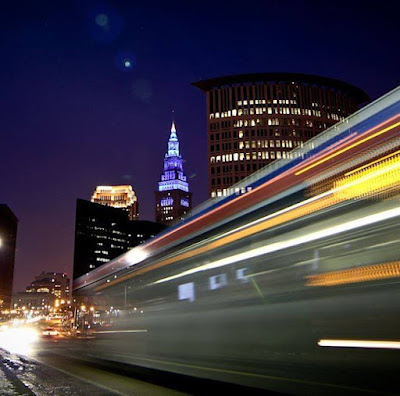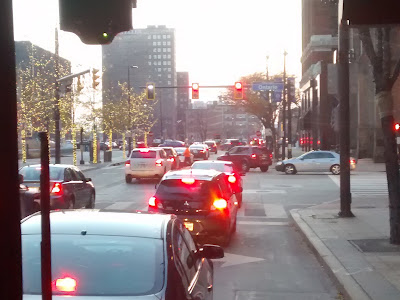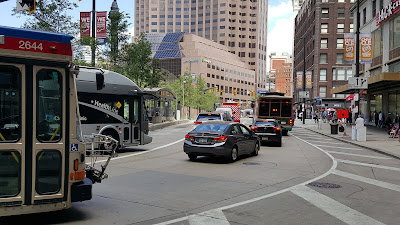Downtown Cleveland Residents (DCR), a community relations board, recently voted to support a rising need for more investment in public transportation, but in an innovative way that boosts economic growth and access to opportunity. Greater Cleveland needs more of both yet funding for public transportation from riders and from all levels of government has been in decline.
To that end, at DCR’s latest community forum conducted virtually, members of the group voted unanimously to support a resolution calling for more transit investment. The demand for transit is growing as downtown’s population nears 20,000. Employers large and small are expanding downtown like Sherwin-Williams, Cleveland Cliffs, Benesch and more. And, before COVID, traffic from rideshare services clogged downtown streets.
Meanwhile, according to the Federal Transit Administration’s National Transit Database, the Greater Cleveland Regional Transit Authority’s (GCRTA) bus and rail services were cut 29 percent since 2006 and the cost of fares doubled over the same period, sending ridership downward. Meanwhile, GCRTA’s backlog of unfunded state-of-good-repair needs such as replacing aging trains, buses, infrastructure and maintenance facilities exceeds a half-billion dollars.
“They (GCRTA) are really up against a wall in terms of funding,” said DCR President Alan O’Connell. “Public transit is a very efficient way for people to move around a city, but the geometry of dense urban environments requires transit to function well, or risk gridlock.”
The resolution echoed this sentiment, referencing two recent studies. One is a 2019 study commissioned by the Greater Cleveland Partnership (GCP) that said “additional non-federal funds will be necessary to meet the existing and future needs of the [GCRTA] system, if heavy rail and light rail are to be maintained as viable transportation options.”
DCR also viewed an increase in resources for public transit as a way to promote neighborhood equity and affordability. The resolution cited a study by Cleveland State University’s Center for Economic Development which found that GCRTA services, where available, results in a 12.3 percent reduction in poverty and a growth of 3 percent in employment. The other study noted was the Ohio Department of Transportation’s Ohio Statewide Transit Needs Study, which found that statewide investment [in public transit] needs to double by 2025 and that all stakeholders should be working towards that funding goal.
The same study also noted the high costs to build structured parking which averages approximately $25,000 per parking space in downtown Cleveland. The high cost produces a low return on investment to developers on newly-built resident parking. It also results in residential rental prices that are higher than both residents and property owners would prefer.
“We spoke to a couple developers who are active in the (downtown) area,” O’Connell said. “They told us that parking is a constant annoyance. They would prefer to dedicate more financial resources toward additional residences and amenities instead of these soon-to-be-obsolete parking garages.”
But how should GCRTA be funded in a way that fosters more economic growth and access to opportunity?
The GCP study says increased funding for GCRTA via a property tax levy would be a more equitable option than by increasing the sales tax. Instead of a traditional property tax, however, DCR recommended a land value tax or a split-rate tax.
“Residents want surface parking lots downtown to be replaced by mixed-use buildings and public greenspace,” O’Connell added. “Current property taxes effectively penalize and discourage development on valuable land. This is completely backwards. There needs to be an incentive to build something that actually contributes to our community instead of encouraging parking lots to continue detracting from it.?
A levy could be placed on the ballot by Cuyahoga County Council or directly by GCRTA’s Board of Trustees, as GCRTA is a taxing authority. Other government entities are also able to introduce bond measures and send the proceeds to GCRTA.
Although GCRTA spokeperson Linda Scardilli Krecic didn’t respond to an e-mail seeking comment on DCR’s recommendations, local and statewide transit advocacy groups did offer their thoughts.
“Clevelanders for Public Transit (CPT) has called on the GCRTA’s board to place a levy on the ballot for years to reverse the death spiral of endless service cuts, fare increases and lower ridership,” said CPT spokesman Christopher Stocking.
In 2018, CPT urged GCRTA to place a levy on the ballot. GCRTA Board President Mayor Dennis Clough responded that a levy would instead be likely be sometime in 2019. Nothing happened, however.
“Well it’s now 2020 and we have seen no action from the GCRTA board,” Stocking said. “CPT agrees funding transit equitably is important. Owners of surface parking lots should be taxed out of existence. This may require action at the county level. In 2017, CPT helped create a standing County Council Committee that is focused on public transit. We look forward to working with Cleveland residents in building support for equitable local transit funding in the future.”
“Other than riders’ fares, no revenue source could be closer to being called a user fee than a land value tax,” said Stu Nicholson, executive director of All Aboard Ohio, a statewide nonprofit group. “We’ve seen the growth in transit-oriented developments around Cleveland’s rail and bus rapid transit stations. Not only do these improve the links between jobs and job-seekers, but if there was a way to capture the land values from future developments, it could support new bus and rail expansions.”
“Transit use and land use density go together, and neighborhoods with the greatest densities have the highest land values,” Nicholson added. “The most valuable land in Cuyahoga County is in downtown Cleveland. Even the wealthiest suburb can’t match the land value per acre of Lakewood, the most densely populated city in Ohio. A land value tax should capture that for the mode of transportation that sustains that density.”
END
- Cleveland, Bedrock seek $1 billion for riverfront development
- CRE industry lauds Bibb’s construction permit overhaul
- Bridgeworks design evolves again – minus hotel
- Cleveland Kitchen wins $10M in tax credits
- Welleon gets an ‘A’ in testing Cleveland’s market
- EPA gives Greater Cleveland $129.4M for five solar arrays, reforestation

















